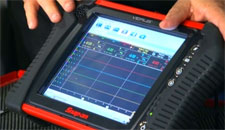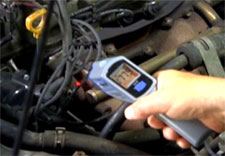Running Hot and Cold
 If something’s wrong with your health, you go to the doctor, and the doctor runs a series of tests to find out what’s wrong. One of the first things they do is take your temperature, because that’s a good indicator of what’s going on. Then they listen-they listen to your heart and your lungs and so on-to see if there’s any problems there.
If something’s wrong with your health, you go to the doctor, and the doctor runs a series of tests to find out what’s wrong. One of the first things they do is take your temperature, because that’s a good indicator of what’s going on. Then they listen-they listen to your heart and your lungs and so on-to see if there’s any problems there.
That also applies to your automobile. Suppose you have a problem with the car-it has a misfire. Check engine light’s on, maybe the check engine light’s flashing; one thing’s for sure, the car is sitting there and it’s real rough at idle. So if you have exotic test equipment like this Snap-On tool, well, fine. Hook it up, you can do the diagnostic work and so on, but not all of us are going to be lucky enough to have something like this.
 So how do you go about doing it yourself? Well, first thing you do is you listen. You go back to the tailpipe and you listen for a “missing” sound, when instead of the gentle purr that an engine normally makes at the tailpipe, you’re going to have-and going to be able to hear-the “missing” sound. Alright. Once you’ve done that, then you come up here and you use your own form of thermometer. This is a digital infrared thermometer. Now the engine is running, it’s fully warmed up. These have a laser pointer on them, and you point the laser at each one of the runners of the exhaust manifold, one at a time. This is a four cylinder engine; you go down the line, you do all four of them. Six cylinder engine, do all six; eight, of course, do all eight.
So how do you go about doing it yourself? Well, first thing you do is you listen. You go back to the tailpipe and you listen for a “missing” sound, when instead of the gentle purr that an engine normally makes at the tailpipe, you’re going to have-and going to be able to hear-the “missing” sound. Alright. Once you’ve done that, then you come up here and you use your own form of thermometer. This is a digital infrared thermometer. Now the engine is running, it’s fully warmed up. These have a laser pointer on them, and you point the laser at each one of the runners of the exhaust manifold, one at a time. This is a four cylinder engine; you go down the line, you do all four of them. Six cylinder engine, do all six; eight, of course, do all eight.
Now, as you shoot each one of these, what you’re going to see on the back of it is the temperature reading of that particular exhaust runner. You’re looking for the one that is significantly colder than the others. “Misfire” means that cylinder isn’t firing, so there’s no heat being generated, so the manifold is going to be colder beside the cylinder that is misfiring. Pretty clever, very easy to do, because you can do this in a matter of a couple of minutes, where even hooking up the scanner is going to take three our four times as long. These are very inexpensive. Depending where you’re buying them, they’ll range anywhere from about twenty dollars to up to eighty bucks. So it’s a very valuable tool to have around the house and around the car.
If you have a question or comment, write to me.
The address is MotorWeek, Owings Mills, MD, 21117.





